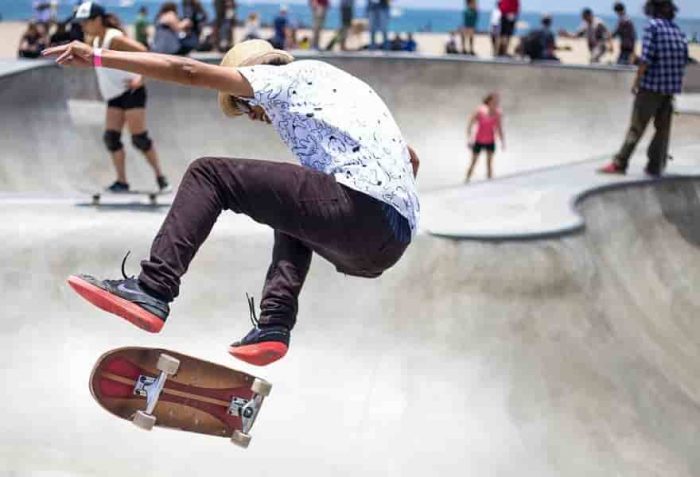Which skateboard deck is right for me? What do I need to pay attention to when purchasing? What is the difference between the different decks? What influence do my body and shoe size have? Answers to these and other questions you get here! Are you looking for a skateboard for your daughter or your son? Here you can get all the information to find the best skateboard for your child:
In the history of skateboarding, skateboard decks have experienced many stages of development and change. Currently, there are specified decks with different shapes, different widths and lengths and special construction technologies for the various applications.
Most decks are made of North American Maple wood, which is particularly stable and resistant due to its slow growth. By default, seven layers of maple wood with water-based glue or special epoxy resin are pressed together under high pressure for a skateboard deck.
The dimensions of the deck are almost always given in the American unit inch. One inch corresponds to the European unit of measurement 1 inch, ie 2.54 cm.
SKATEBOARD DECKS: STRUCTURE &
Normally, a skateboard is 28 “- 33”, which is about 70 – 80 cm long.
The board is divided into three sections: the nose (front), the wheelbase (between the axles) and the tail (rear). To find out where the front and back are, you should take a closer look at the deck. The nose is usually slightly wider and steeper than the tail.
Tip: The deck’s design can also help you differentiate between nose and tail. Mostly the graphics are designed so that the nose is up or to the left.
Nose and Tail are the rounded ends of your deck that are more or less arched upwards. There are flatter and steeper versions. The theory is that a steeper nose and tail will give your deck more pop due to the higher leverage. A flatter nose and tail give you a better board feel.
The Wheelbase is usually 12 “- 15” long and not only affects the overall length of your deck, but also on the handling. Shortened, one can say: The shorter the deck, the more agile it feels and the longer, the smoother the deck becomes.
1.2 SKATEBOARD DECKS: CONCAVE
Concave is the long-sided curvature of the deck. The higher this camber, the more pressure you can put on the edges, which improves the deck’s steering and flip behavior. Skateboard decks are generally divided into low, medium and high concave. Which concave is most comfortable for you, you will find out by tasting. We recommend beginners to start with a medium concave skateboard deck.
Unfortunately, the manufacturers give very little information about the concave of their decks. Therefore, a Medium Concave from Brand X can be much different than the Medium Concave from another brand. Due to variations and tolerances during the manufacturing process, you can not always assume that the concave of two identical decks is 100% identical.
LOW CONCAVE:
Low concave skateboard decks have only a slight curvature. This leads to a more stable handling, but also to less maneuverability. In addition, low concave decks can be a bit trickier.
MEDIUM CONCAVE:
Medium concave decks are the compromise between low concave decks and high concave decks. If you’re not sure which concave suits you best, then you’ll probably get along well with a medium concave in the beginning. Most skateboard decks are in the medium concave shape anyway.
HIGH CONCAVE:
High concave skateboard decks have a very pronounced curvature, making the deck more manoeuvrable and flipping it better. However, high concave decks do not forgive you as much mistakes as medium or low concave decks.
1.3 SKATEBOARD DECKS: SHAPE
Street skating, bowl and vert as well as cruising make different demands on a skateboard deck. For this reason, various shapes have developed that best meet the respective requirements.
STREET SKATEBOARD DECK
A standard skateboard deck for the street and park area features the twin-tip shape. This means that the nose and tail are shaped almost the same, so you can just switch. This so-called popsicle shape has been the standard for years when it comes to the shape of skateboard decks.
switch = The position when you move forward, but the foot that normally stands on the tail stands on the nose. Incidentally, this is not to be confused with fakie. Fakie is the reversing of the deck. The tail shows while driving while your foot position remains the same.
POOL / BOWL DECK:
Skateboard Decks for transition skating are usually a bit wider. For this purpose, decks are usually used starting from a width of 8.25 “ascending. In addition to the normal but wider street skateboard shapes, there are also shapes reminiscent of old school skateboards. These are now summarized under the term Shaped Decks.
SKATEBOARD DECKS FROM 8.25 “SHOP OLDSCHOOL POOL & BOWL DECKS IN SHOP
SHAPED DECKS:
The hybrid form of the New School Street Decks and Old School Pool Decks has established Shaped Decks in recent years. These decks were originally designed for transition lovers who are also up for a street session. Thanks to their pronounced concave and bent nose and tail, they not only have a real transition rocket, but also the opportunity to drive in the street area and do various tricks.










Read 0 comments and reply